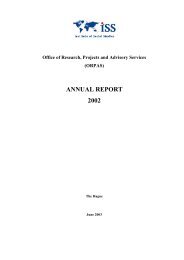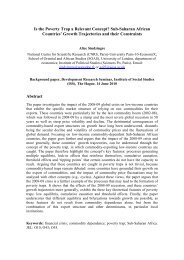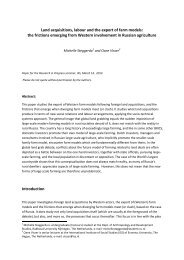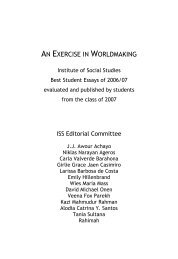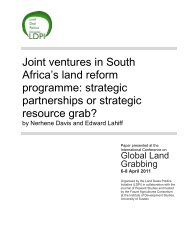AN EXERCISE IN WORLDMAKING 2009 - ISS
AN EXERCISE IN WORLDMAKING 2009 - ISS
AN EXERCISE IN WORLDMAKING 2009 - ISS
Create successful ePaper yourself
Turn your PDF publications into a flip-book with our unique Google optimized e-Paper software.
88 MEKALIA PAULOS AKLILU<br />
posed to generating, it tends to redistribute wealth and income through<br />
what he refers to as accumulation by dispossession, a modern day manifestation<br />
of “primitive accumulation”, which Marx believed to precede the<br />
establishment of capitalism. Thus, it is first and foremost, a project and a<br />
conscious process, an articulation of interests, rooted in a capitalist politics of<br />
production which seeks the incessant accretion of wealth (Harvey, 2005).<br />
Particular interests seek to rule others, however require legitimacy via<br />
ideas of certain interest groups that emanate from their positions in the<br />
existing division of labor. To this end, noble ideas such as freedom , liberty,<br />
self-regulating market, and prosperity are used to co-opt the masses<br />
into accepting it as a hegemonic discourse, as though there is no other<br />
alternative.<br />
PRE-1997 SOUTH KOREA: <strong>AN</strong> UN-NEOLIBERAL ASCEND<strong>AN</strong>CY<br />
From the ashes of World War II and the Korean War soon afterwards, a<br />
roaring tiger rose from the humble beginnings of one of the poorest<br />
places, making its mark on the global arena, transforming itself into one<br />
of the most advanced industrial economies in a span of no less than 40<br />
years. With an exceptional long-term development record, this was nothing<br />
less than a true miracle, a marvel of its counterparts. Its phenomenal<br />
leap from tungsten, fish and other primary commodity exports to becoming<br />
the abode of Samsung, LG and Daewoo was attained through a<br />
skilful fusion of market incentives and state direction, the latter more<br />
prominent in its institutional configuration (Chang 2007: 3-14). Fashioned<br />
in the image of the Japanese model, it was a rather un-neoliberal ascendancy,<br />
a testament to the intrinsic worth of a developmental state<br />
(Bello 1998, Harvey 2005). As such, it posed a direct challenge to the<br />
neoliberal approach.<br />
Perhaps there was no one-size-fits-all model of economic growth after-all.<br />
Predictably, this indeed ruffled feathers as it was eroding the superiority<br />
of the pro-market advocates. The very foundations of neoliberalism<br />
were being probed (Robison and Kewison 2005: 188). Furthermore,<br />
over a decade of structural adjustment packages that were unswervingly<br />
being conferred on developing countries elsewhere were not<br />
yielding the much sought after results, thus a replication of the East<br />
Asian model seemed to loom ever the larger on the horizon. Moreover,<br />
initially assisted by the United States during its economic expansion for<br />
strategic reasons relating to the Cold War, the spectacular progress of




